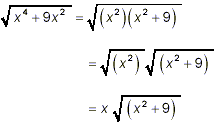Simplifying Square Roots
An expression containing a square root is considered to be as
simple as possible when the expression inside the square root is
as simple or small as possible. The reduction of the contents
inside the square root is accomplished (when possible) by a very
straightforward strategy:
(i) Factor the expression inside the square root completely.
Write factors which are perfect squares as explicit squares.
(ii) Use the property that the square root of a product is
equal to the product of the square roots of the factors to
rewrite the square root from step (i) as a product of square
roots of factors which are perfect squares and a single square
root of an expression which contains no perfect square factors.
The pattern is:

where u, v, etc. are perfect squares, and w is an expression
containing no perfect square factors. (This may seem a bit
abstract, but the meaning of this pattern should become more
obvious after you have studied a few of the examples below. It is
important in mathematics not only to study specific examples of a
type of operation, but to eventually understand an overall
general strategy or pattern for similar types of problems.
(iii) Replace the square roots of perfect squares by factors
which are not square roots using the property

We now illustrate this general strategy with a series of
specific examples.
Example 1:
Simplify 
solution:
There is a strong temptation here to simply take the square
root term by term to get

However, you should see immediately that the first step
violates the previously stated properties of radicals and so is
invalid. The only way we can simplify this expression is if we
are able to first factor it into a product in which one or more
factors are perfect squares. Here, the expression x 2 + y 2
cannot be factored using any of the techniques available to us,
and so no progress can be made as far as simplifying this square
root. We are forced to conclude that the given expression is
already in simplest radical form, and nothing can be done to
reduce the expression inside the radical to a simpler algebraic
form.
Example 2:
Simplify 
solution:
There seems to be a lot of perfect squares here – in
fact, x 4, 9, and x 2 are all perfect squares. However, only
perfect square factors of the entire expression in the radical
are of any use to us here. Proceeding using the methods for
factoring algebraic expressions that were covered in detail
earlier in these notes, we get x 4 + 9x 2 = x 2(x 2 + 9) as the
most complete factorization possible. Thus

Again, the expression left in the square root in this last
line cannot be factored further at all, and so we cannot extract
any further perfect square factors inside the square root to
allow further simplification of the square root. Thus

must be the final answer here.
|